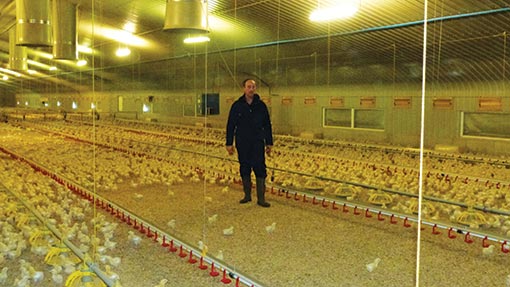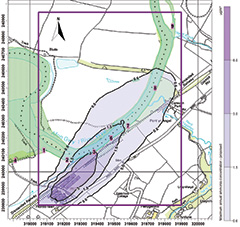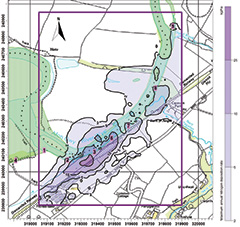New service from Met Office for poultry farmers

The Met Office is best known for forecasting the weather. Not many people know that it also works to provide air quality management and dispersion modelling services to farmers. Phil Edgington of ADAS explains
With demand for poultrymeat on the increase – in part due to last year’s horsemeat scandal – many poultry units are currently focused on expansion.
To achieve this, they will have to fulfil stringent requirements concerning pollution controls in both permit and planning applications, to account for the potential environmental impacts of larger stock levels and expanded or new housing.
Two of the main environmental problems they face are odour emissions and ammonia. Strict odour management legislation and Integrated Pollution Prevention and Control (IPPC) regulations require businesses to act on environmental benchmarks when planning new housing.
They have to take into account the nature and proximity of a variety of local features, including human habitations, protected woodland, rivers, lakes and bog land, and other eco-systems, many of which could be easily degraded by ammonia pollution.
In addition, it is essential that local meteorological conditions, in particular wind direction, are used to make assessments of potential pollution effects. And any assessment of the amount and concentration of poultry housing emissions will have to be added to existing background emissions from other farm operations.
The potential impact of ammonia on protected ecological sites is increasingly one of the “make or break” factors when it comes to assessing the feasibility of potential sites for new or expanded poultry units.
It is here that a service from the Met Office Rural Environment Team (Moret), working with consultants at ADAS, can help businesses measure and overcome the potential effects, and so gain the necessary permits and planning approval for their projects.
They are able to provide poultry operators and their consultants with expert, site-specific advice on pollutant air dispersion and odour management mitigation.
Factoring in all the meteorological conditions in relation to the local environment and the proposed size and position of new housing, Moret can produce models that will accurately assess potential pollutant concentrations and any ensuing damage for a particular area.
The models can analyse not only ammonia and odour pollution, but also the waste products of farm combustion facilities and other activities, such as gasses, particulates, metals and other substances which can cause pollution and threaten human health in the local community.
All of this information is required for the air quality assessments needed to support environmental permit and planning applications.
Phil Edgington works for the Met Office Rural Environment Team (Moret) and ADAS in Wolverhampton.
Ammonia case study: Ffordd Fawr Farm, Herefordshire
The problem
Herefordshire farmer Mark Eckley wished to meet increased demand for chicken by building more houses to accommodate extra birds. They would require both an Environmental Permit and planning permission.
But the Environment Agency will only issue a permit if it is satisfied that any expansion to a poultry operation does not break stringent rules on environmental pollution for the local area. Generally, levels of ammonia in the UK are falling, though the main source is agriculture, and livestock production in particular.
Some habitats are sensitive to increases in atmospheric ammonia concentrations, which can lead to increased nitrogen deposits on land. These deposits then have a fertilising effect, distorting the natural habitat, and can also lead to acidification and eutrophication of soils.
 |  |
|---|
Modelling software demonstrates how (above) nitrogen will be deposited on the surrounding area following the proposed expansion of Ffordd Ffawr Farm, and makes a similar assessment (right) for ammonia emissions.
This map is reproduced from Ordnance Survey material with the permission of Ordnance Survey on behalf of the Controller of Her Majesty’s Stationery Office © Crown copyright. Unauthorised reproduction infringes Crown Copyright and may lead to prosecution or civil proceedings. ADAS licence no. AL100020033. August 2012.
High concentrations of ammonia can also damage woodland, for example, causing leaf scorching and loss. It is also possible that ammonia pollution has led to changes in plant morphology.
Ffordd Fawr Farm is in a mountainous area of Herefordshire. Nearby there are several sensitive conservation sites and the River Wye SSSI (Site of Special Scientific Interest) is a mere 90m from the poultry unit.
The planned expansion of the Ffordd Fawr Farm poultry unit involved the construction of three new houses to add to the existing four, though one of these would be replaced (see diagram).
Moret used the Atmospheric Dispersion Modelling System (ADMS) developed by Cambridge Environmental Research Consultants, a “new generation” Gaussian plume model, to accurately represent the magnitude and concentration of ammonia emissions from the poultry unit. The model was further refined to analyse how local conditions, such as topography and land use, would influence the nitrogen deposition processes.
The ADMS model was then run with weather data specific to the farm location, derived from the Met Office mesoscale model, on wind speed and direction and the state of the atmosphere. This predicted the atmospheric ammonia concentrations and degree of deposition of nitrogen to the land in the area around the poultry unit and at the boundaries of the sensitive ecological sites.
The model was run for both the existing and proposed poultry units.
Findings
The ADMS model showed that the initial plans for an expanded poultry unit would lead to an unacceptably high increase in ammonia concentrations and nitrogen deposition rates at the sensitive conservation sites.
After an extensive review, a number of other models were run in order to test the effectiveness of different mitigation measures. These included:
- Reducing the number of new houses and birds at the expanded unit
- Modernising ventilation systems on some, or all, of the poultry houses
- Implementing heat exchangers on some, or all, of the poultry houses
As a result, a revised plan was made which the Moret modelling proved would reduce the negative effects on the local conservation sites in comparison to the existing poultry unit.
As a result, Mr Eckley chose a configuration for the expanded poultry farm which was best for the environment and his application for an Environmental Permit was successful. He was able to expand his poultry unit, safe in the knowledge that in developing his business he was helping to conserve local ecosystems and areas of natural beauty.
Conclusion
To achieve the environmental permit and planning consents that are a prerequisite for the development of new and expanding units, the developer needs to prove to the Environment Agency and local planning officers that its activities are not harmful to the environment or people’s health.
The Environment Agency sets the bar high for its permits. By combining its expertise in dispersion modelling and meteorological science with ADAS’s knowledge of farming emissions, environmental impact assessments, ecology and poultry farm management, Moret can help poultry farmers get over this bar.
Moret can also provide advice on the design and installation of poultry housing that will best fulfil the criteria for environmental permit and planning permission applications, and can supply expert witnesses to testify before appeal hearings.
Having scientific help in unravelling the complexities and mitigating the risks of potential environmental pollution, poultry operators are in a better position to concentrate on expanding the business and increasing profit margins.
